Sitting casually along the roadside on Costa Rica’s Nicoya Peninsula is the Curu National Wildlife Refuge. Marked by a few simple signs, most travelers race past this reserve on their way to destinations like Montezuma, Tambor, and Santa Teresa. But for those who do stop, an abundance of wildlife and variety of habitats are waiting to be explored. In this post, we’ll tell you all about the Curu National Wildlife Refuge so you can plan a visit.
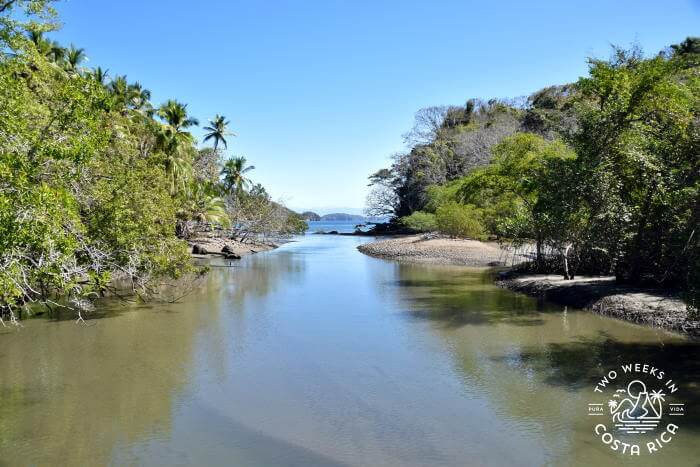
Orientation
Curu National Wildlife Refuge is located on the southeastern side of Costa Rica’s Nicoya Peninsula. It’s between the small tourist town of Tambor and locals’ town of Paquera.
Paquera is best known for its ferry terminal where the Puntarenas Ferry arrives and departs. This large boat transports passengers and vehicles to and from the southern part of the Nicoya Peninsula, saving a lot of driving miles.
Most people visiting Curu National Wildlife Refuge stay in nearby Tambor or Montezuma. The reserve also has some very simple lodging.
Curu is about 3 hours south of LIR Airport in Guanacaste and 4 hours west of SJO Airport, including the ferry ride.
Tip: This area is best explored with a rental car since beaches and attractions are spread out. If you are looking to rent a car, check out our discount through one of the largest and most reliable agencies.
About the Curu Reserve
Before becoming an official wildlife refuge in 1981, the vast property of Curu was used for many purposes, including farming and tree harvesting. Later those practices were scaled back to make way for conservation and ecotourism.
Today, Curu National Wildlife Refuge protects 75% of its 3,697 acres (1,496 hectares) as pristine forest. The remaining 20% is used for farming/ranching, while 5% makes up the reserve’s hiking trails and visitors center.
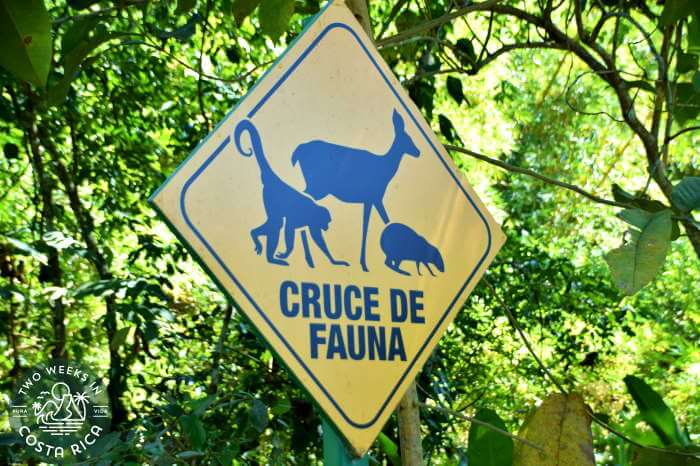
A Variety of Habitats
One thing that makes Curu National Wildlife Refuge so special are the variety of habitats on the property. There is tropical dry forest, wet forest, mangrove, pasture, beach, and marine zones.
This makes it especially attractive to wildlife like birds as well as mammals, reptiles, amphibians, insects, and of course fish.
During our visit, we saw a lot of wildlife hanging out near the streams and mangroves.
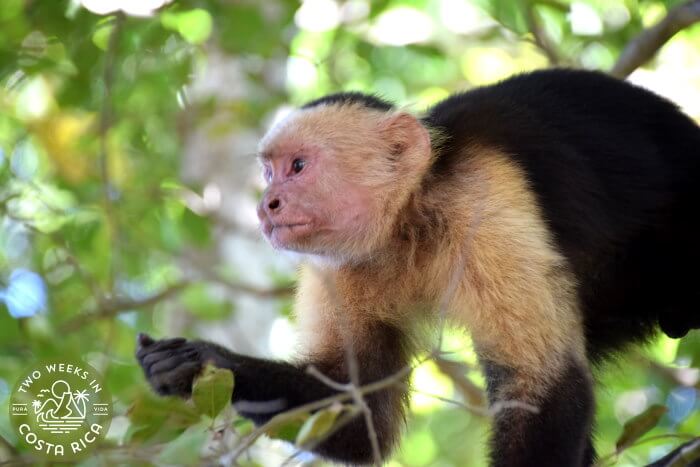
Visiting Curu National Wildlife Refuge
The Trails
From the visitors center at Curu National Wildlife Refuge, you can walk along several trails to make a loop. Each one is unique and will allow you to see some of the different habitats.
A few of the trails were closed when we visited. Here are some of the major trails that make for a good hike.
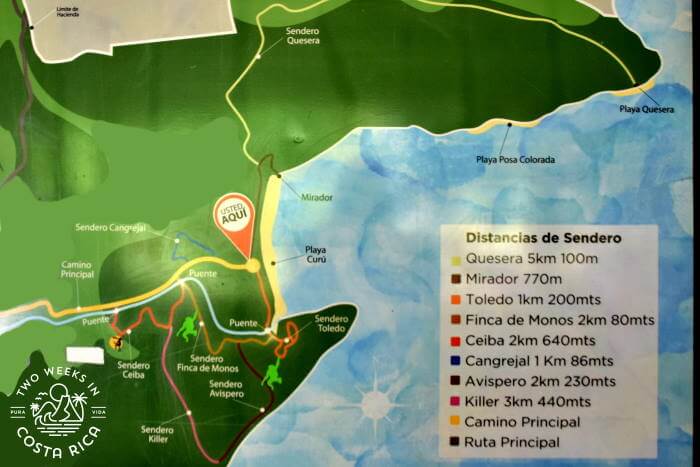
Manakin Trail – Sendero Toledo
This short 200-meter (0.12 mile) trail is named after the Toledo bird (Long-tailed Manakin) that can be found inside the reserve. It starts at the visitors center and goes south along Playa Curu. Along the beach trail, there are some picnic tables nestled into the shrubby forest.
We came back to this spot after our hike to cool down and have a snack. Beware that there can be wildlife looking to grab your food. We saw both racoons and white-faced monkeys, which were aggressively trying to investigate our cooler.
It is important not to feed these animals as you can make them very sick. They also become more aggressive towards future visitors.
After the beach section, the Toledo Trail has a long, rustic bridge that crosses a tidal river. We saw lots of fish swimming in the shallow water as well as birds and iguanas along the banks. Signs also warn of crocodiles.
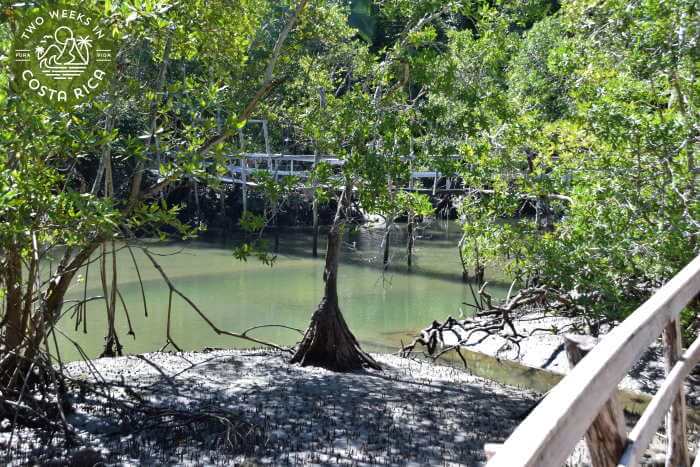
Monkey Farm Trail – Sendero Finca de Monos
After the Manakin Trail is a turnoff for the longer Monkey Farm Trail (Sendero Finca de Monos). This trail is roughly two kilometers (1.25 miles). There are a few ups and downs along this trail, but the hike overall is fairly flat and easy.
The Monkey Farm Trail goes inland through some of the tidal mangrove forest before transitioning to a normal lowland jungle.
During our visit, it was low tide so the roots of all the mangrove trees were exposed. There were lots of crabs peeking out of their holes and foraging for food. We also saw a giant Ivory-billed Woodpecker up in the trees.
This trail eventually ends at a small stream and the entrance road. If you are looking for a short hike, you can simply follow this road back to the parking area and visitors center.
Where the trail curves around the stream (near the road), we saw a large family of howler monkeys lounging in the tall trees. Make sure to keep an eye up to the trees around this area. At first the monkeys were being very quiet and were hardly noticeable. Later they started calling with their loud calls, which made them easier to spot.
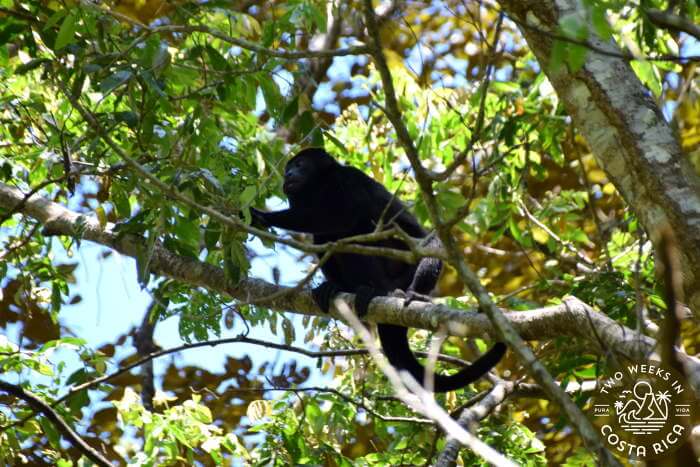
Ceiba Trail – Sendero Ceiba
If you want to continue hiking from the Monkey Farm Trail, you can trek along the Ceiba Trail. This trail continues inland another two kilometers (1.25 miles) before meeting up with the entrance road. Like the other trails, it is fairly flat and easy.
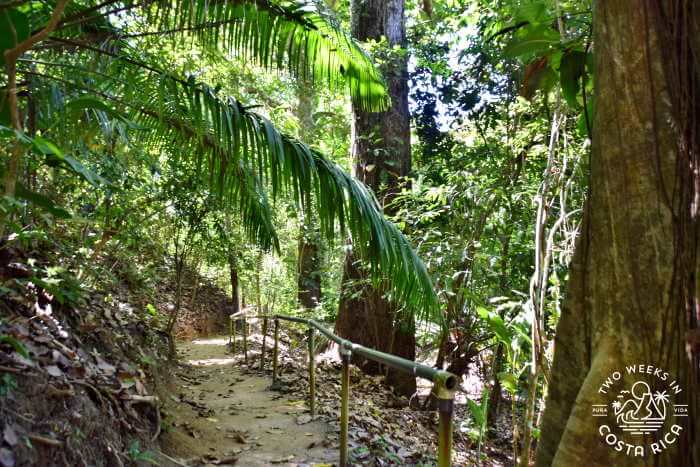
The Ceiba Trail was interesting for us because it went past some little waterways, which had small fish in them. Our kids loved looking in these puddles to see what they could find.
The water also attracted some animals called agouti. These are small rodents that sort of hop like rabbits. They are really shy and eat fruits and vegetation off the forest floor.
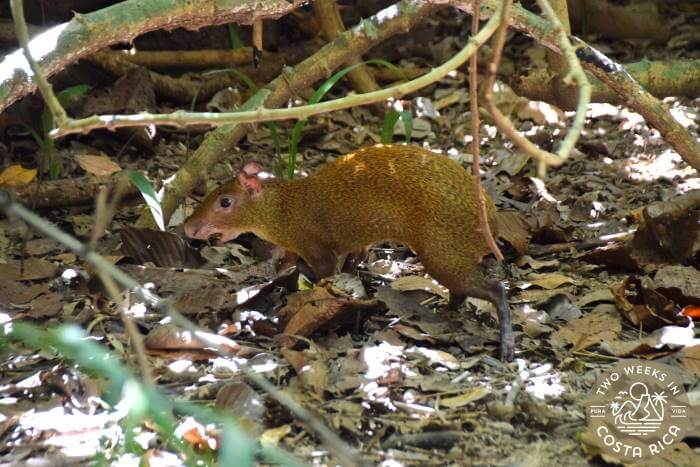
Another highlight on the Ceiba Trail is a manmade lagoon near the end. The lagoon is sectioned off with a fence and gate. That is because there are crocodiles inside! When we visited, one was sunning itself right in the shallow water. It was small but still intimidating.
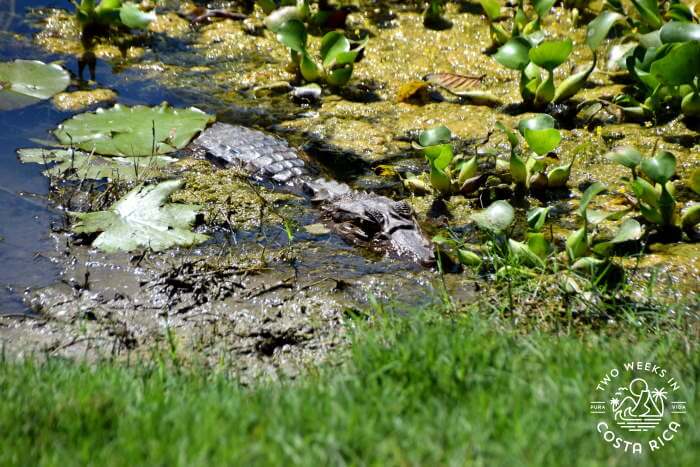
Entrance Road – Camino Principal
Though technically not a trail, we would be leaving out an important part of the reserve if we didn’t mention the entrance road. You walk this back to the visitors center after leaving either the Monkey Farm Trail or Ceiba Trail.
It was along this road that we saw a lot more wildlife. First, it was a family of coati (pizote), which are similar to racoons but have a long snout and slender tail that they often stick straight up in the air. They were foraging under some dead logs, digging up insects to eat.
We also saw a lot of white-tailed deer along this road. They were a bit shy but also curious and let us get close enough to get some nice pictures.
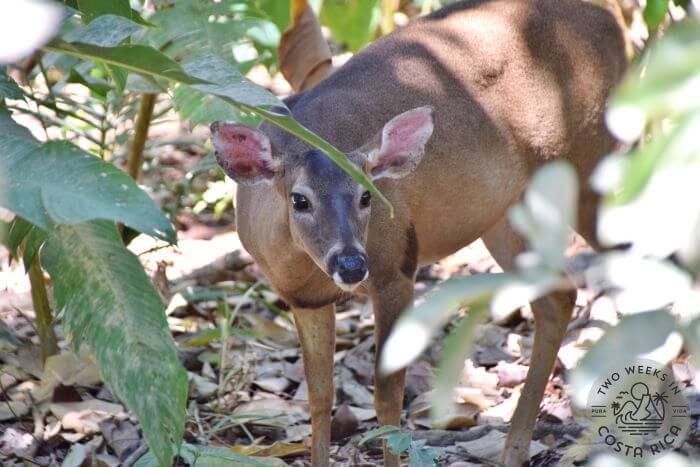
Crab Trail – Sendero Cangrejal
The last trail we took was Sendero Cangrejal, named after the land crabs in the area. At times, these crabs, which live inland, flock to the water in droves to breed. They march across roads, fields, and mountains, no matter what is in their way.
On this flat, one kilometer (0.62 mile) trail, you loop around a section of sparse forest and mangrove. We didn’t see much in this area, but it was later in the day and very hot. It could be much better for birds and animals during the early morning or late afternoon.
Closed Trails
A few of the trails inside the Curu National Wildlife Refuge were closed at the time of our visit. Notably, the long (5 km/3.1 mile) trail to Playa Quesera was closed. This is supposed to be a gorgeous, pristine beach.
Also closed were the Avispero (Hornet’s Nest) and Killer Trail. Based on those names, we weren’t too disappointed.
Accessibility
Although some of the trails above are flat and easy, they still have uneven parts that would be difficult for someone with limited mobility. However, the entrance road, as well as the area around the visitors center and beach can still offer a pleasant experience and plenty of wildlife viewing.
Other Things to Enjoy
Restaurant & Gift Shop
There is an onsite restaurant and gift shop at the Curu visitors center.
The restaurant serves traditional food. It’s best to order what you would like inside the gift shop before starting your hike. That way, they can prepare. Otherwise, you might be waiting a long time to eat.
Inside the gift shop is a nice selection of T-shirts, souvenirs, and handmade gifts, as well as some cool old photos of the area.
Curu Beach
With your admission, you also can enjoy the remainder of your day at Playa Curu. The beach is set in a wide cove and is very tranquil. There are only gentle waves, making it a great place to swim with kids. There is some shade near the visitors center, but again, watch out for the aggressive monkeys!
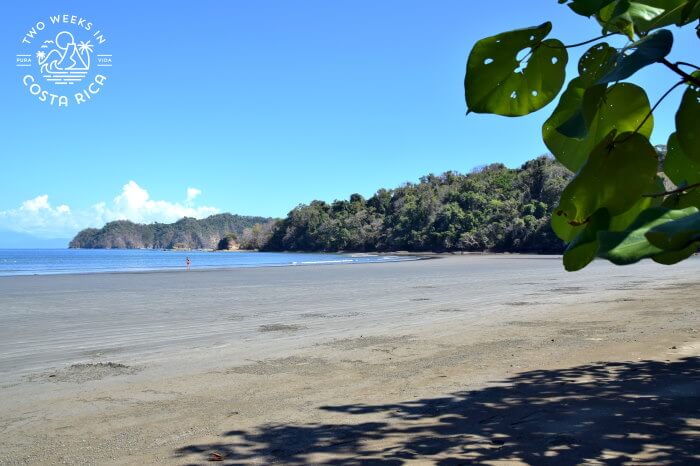
Tours
If you have more time to spend at Curu National Wildlife Refuge, you can take some of their tours. They offer horseback riding, kayak rentals or tours, night tours to see bioluminescent algae, and day tours to Tortuga Island. The activities are very affordable; for example, horseback tours are $15 per hour.
The tours do not include the entrance fee, so if you plan to come back another day for tours, you will have to pay the entrance again.
Planning Your Visit
What to Wear & Bring
We recommend wearing lightweight clothing, sturdy shoes for walking/hiking, and a hat for sun protection. Be sure to bring along some sunscreen, insect repellent, and a lot of drinking water since the trail can be very hot.
For more tips on what to pack in your daypack, see this post.
Hours
Open Daily, 7:00 a.m. to 4:00 p.m.
Admission Cost
Adults: 9,000 colones (foreigners). 3,000 colones (nationals).
Children: 3,000 colones (foreigners). 1,500 colones (nationals).
Conclusion
We really enjoyed our visit to Curu National Wildlife Refuge. We had driven past this reserve many times but hadn’t had the chance to stop. We always wondered if it was worth the effort to visit. Now we can definitely say that it was, and we are already looking forward to going back again. We hope you’ll go and experience it too.
Have a question about visiting Curu National Wildlife Refuge? Leave a comment below.
Looking for more information to help you plan your trip? Check out these articles:
Tambor: A Relaxing Escape on the Nicoya Peninsula – Learn all about the Tambor area with this post. Includes accommodation recommendations.
Taking the Puntarenas-Paquera Ferry – This is the ferry that you will likely take to reach the southern Nicoya Peninsula if flying into SJO Airport. We cover all the details.
Renting a Car in Costa Rica: Clearing up the Confusion – If you want a car to explore this area of the country, read this article to find out how the insurance works and what else to watch out for.
A Bioluminescent Kayak Tour on the Nicoya Peninsula – This tour is located near the Curu Reserve. It’s an amazing experience to see the natural phenomena of glowing algae in the sea.
